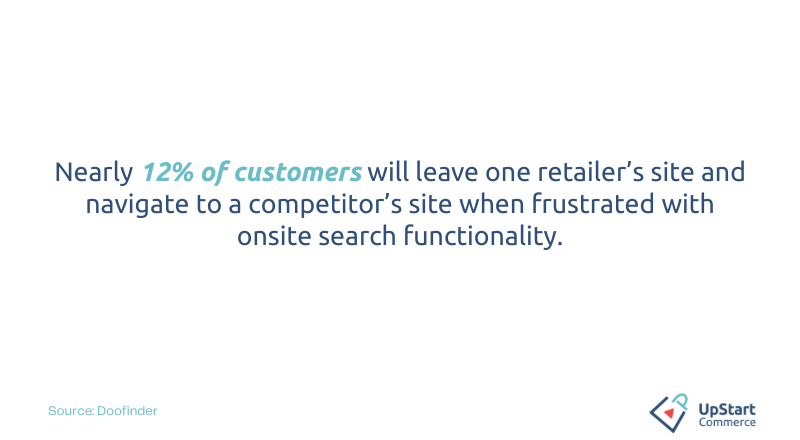What is the true cost of having a poor onsite search experience for ecommerce customers? When customers have a subpar search experience on an ecommerce website, retailers face significant losses.
Data shows that onsite search plays a huge role in customer journey, and therefore leads to more conversions. According to Doofinder, 63% of retailers are unsatisfied with their site’s search engines. Nearly 12% of customers will leave one retailer’s site and navigate to a competitor’s site when frustrated with onsite search functionality.

It is crucial to prioritize both the functionality of your ecommerce search bar and the overall user experience. A frustrating search process can be just as detrimental to your profits as relying on a product discovery solution that is not tailored to ecommerce needs.
In this blog we discuss important query match types for search results, how to improve a retail site’s search functions, and why search matters in ecommerce.
User Knowledge for Onsite Search Results
Customers expect a site’s search bar to help them find an exact product or similar products quickly. Using a site’s onsite search should simplify the product discovery experience, not create additional roadblocks.
Understanding Search Queries
Many customers use phrases, abbreviations, synonyms, and misspellings when searching for products. It is important that a site’s search functionality supports misspellings, synonyms, and abbreviations in search results. However, nearly half of retail websites do not support these simple needs.
Searching Category Synonyms
While one user might search for “sneakers”, another might search for “tennis shoes” while expecting the same results. It is important to offer the customer results for all synonyms to help them find their intended product without constraining the results to their exact phrase.
Descriptive Attributes in Search Terms
Imagine searching for “linen couch” and landing on a search result page full of leather, suede, and microfiber couches as well. This is going to hinder the customer’s product discovery process and may tempt them to try your competitor’s website. It is important to serve search results that can filter out irrelevant results based on attributes in the search term.
Improving Onsite Search
Retailers can use data gathered from users’ onsite journeys to further understand customer behaviors. By analyzing their behavior, preferences, and search patterns, retailers can optimize onsite search experiences and drive better outcomes.
Focus Group Data
Retailers can use information such as a user’s thought process and emotions while using the search functionality by conducting interviews and focus groups. However, this method is hard to scale and leverage on a larger scale.
First Party Data
First-party behavioral data such as add-to-carts and clicks can help create personalized shopping experiences. This real-time data can help serve users relevant results such as recommended products.
Analytics
Merchandising teams can utilize analytic dashboards to understand user behaviors. Analytics help them gather insights from one unified location on the backend of their website.
Why Does Onsite Search Matter in Ecommerce
In conclusion, a poor onsite search experience in ecommerce leads to frustrated customers, lost revenue, and increased churn. Optimizing the search bar and user experience is important for driving conversions and maximizing profits. Retailers who understand user behaviors, support synonyms and contextual queries, and deliver relevant results enhance the search experience. Leveraging qualitative and quantitative data enables informed decision-making. Prioritizing search bar optimization improves customer satisfaction and business outcomes. Investing in a seamless search process is essential for long-term success in ecommerce.
Learn more about UpStart Commerce’s smart search functionality and start giving customers what they really want.
